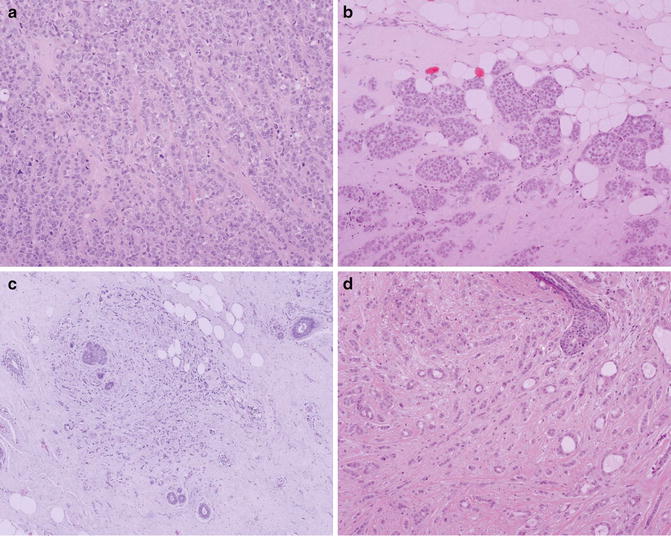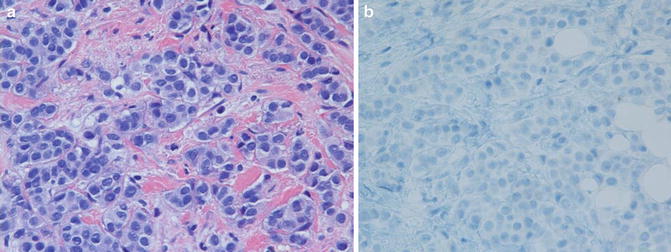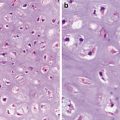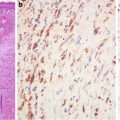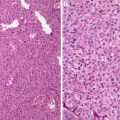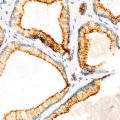(1)
Department of Pathology Beckley Veterans Medical Center (West Virginia), McGuire Veterans Medical Center, Virginia Commonwealth University, Richmond, VA, USA
The Low-Grade Breast Neoplasia Family
Key Morphological Features of Low-Grade Ductal Carcinoma In Situ (DCIS)
Cribriform, papillary formation with uniform round or columnar cells
Regular cell placement with preserved cell polarity around lumens (Fig. 10.1)
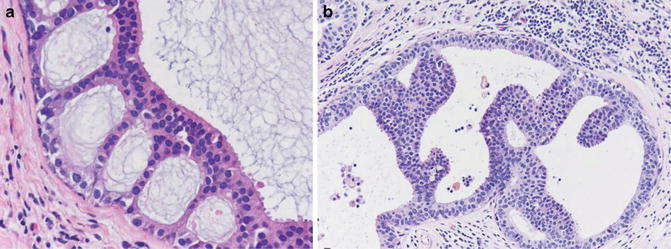
Fig. 10.1
Low-grade ductal carcinoma in situ. Cribriform and papillary structures composed of uniformly bland cells (Breast Pathology, Elsevier/Saunders, 2012 with permission)
Key Morphological Features ofClassical Lobular Carcinoma In Situ (LCIS)
Lobular extension (>½ of a lobule)
Small, uniform, loosely cohesive small cells (Fig. 10.2)
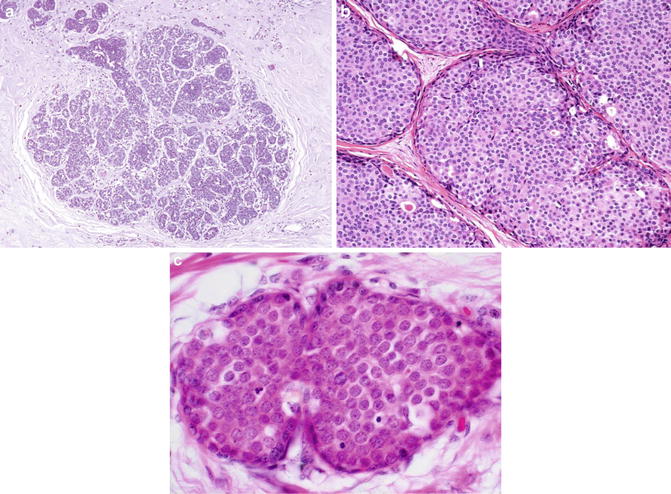
Fig. 10.2
Lobular carcinoma in situ. Expanded lobules composed of uniformly bland cells (Breast Pathology, Elsevier/Saunders, 2012 with permission)
Key Morphological Features of Columnar Cell Lesion (CCL) and Flat Epithelial Atypia (FEA)
Dilated cystic structures
Monomorphic cell population with preserved cellular polarity (Figs. 10.3 and 10.4)
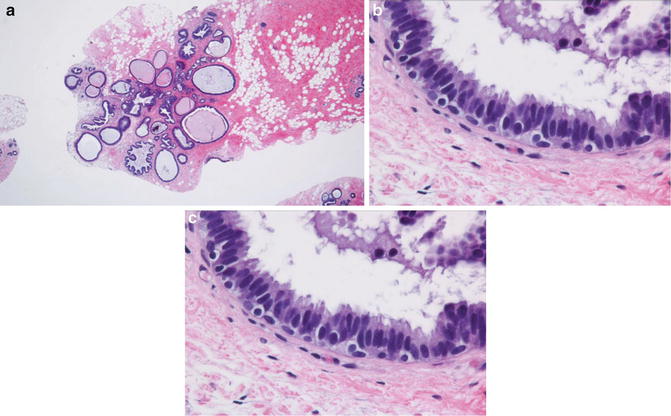
Fig. 10.3
Columnar cell lesion. Dilated cystic structures composed of uniformly bland columnar cells (Breast Pathology, Elsevier/Saunders, 2012 with permission)
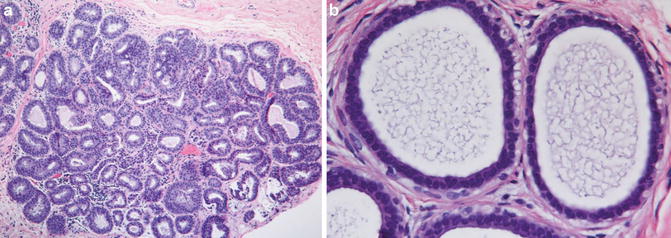
Fig. 10.4
Flat cell lesion. Dilated cystic structures lined by uniformly bland flat cells (Breast Pathology, Elsevier/Saunders, 2012 with permission)
Discussion
Review of Pertinent Mammary Gland Development and Histology
The postnatal development of the mammary gland is a very complicated process orchestrated mainly by the concerted efforts of systemic steroids, peptide hormones, as well as local growth factors [1–3]. In the process which can span up to 50 years, the gland goes through four tightly regulated stages: ductal morphogenesis, lobuloalveolar development during pregnancy, synthesis and secretion of milk proteins and lipids at lactation, and involution following weaning. In addition, the ductal and lobular structures also undergo cyclic changes (proliferation and apoptosis) corresponding to the menstrual phases. Derived from the terminal end buds (TEB), the adult mammary functional and histological unit, terminal duct lobular unit (TDLU), is the site where most breast lesions arise. Upon close review of the TDLU, one could discern three distinct parts of the unit with each of them having their corresponding benign and neoplastic simulators (Fig. 10.1).
The ductal part:
Ductal hyperplasia → DCIS → invasive ductal carcinoma
The lobular (acinar) part:
Adenosis, lobular hyperplasia (lactation) LCIS → invasive lobular carcinoma
The junction part:
Tubular adenosis and blunt duct adenosis, columnar cell lesion/flat cell atypia → tubular carcinoma
In breast pathology, the designations “lobular,” “ductal,” and “tubular” only denote the neoplastic cell differentiation rather than the actual tumor site. Understandably, the in situ component of one type can progresses into or associate with another type of invasive carcinoma.
A well-developed myoepithelial layer lines almost the whole gland system except for a short segment of the collecting duct at the nipple orifice. This layer plays a very important chaperone role in the organogenesis and functions of the gland (see more discussion in the invasive carcinoma section).
The Low-Grade Concept and Cellular Changes
The concept of low-grade breast neoplasia family has gained increasing recognition in recent years. Included in this family are low-grade ductal carcinoma in situ (DCIS), lobular carcinoma in situ (LCIS), columnar cell lesion (CCL), flat epithelial atypia (FEA), and low-grade invasive carcinoma. This family shares characteristic deletion of 16q and gains of 1q and 16p [4–6]. The preinvasive lesions in this family are characterized by two morphological features: a bland and monomorphic cell population and presence of a peripheral myoepithelial layer. Compared to benign proliferative lesions (ductal hyperplasia in particular), the neoplastic precursor cells are actually more mature and differentiated toward luminal cells probably as a result of increased proliferation of estrogen receptor (ER) expressing cells which rely on autocrine growth factors.
The low-grade precursor lesions are clonal proliferations of apparent luminal cells or transit amplifying cells in which the differentiation switch toward myoepithelial is inactivated [7, 8]. This clonal proliferation of mildly defective cells accounts for the cellular monotony and blandness of low-grade precursor lesions. This cellular feature tends to get neglected if the stereotypic picture of dysplasia (increased N/C ratio and cellular polymorphism) predominates in the mind’s eye of the pathologist. This feature is particularly important in their distinction from florid ductal hyperplasia which has many features of dysplasia. An analogy exists in lymph nodes where a low-grade B cell lymphoma contains a monomorphic cell population, whereas reactive cells are polymorphic and even alarmingly atypical.
LCIS cells have lost their adhesion molecule E-cadherin and thus are loosely cohesive, whereas the molecule expression is preserved in DCIS, CCL, and FEA accounting for their cellular cohesiveness and maybe even polarity. This important feature is often used in the distinction between pleomorphic lobular carcinoma from high-grade ductal carcinoma and in the diagnosis of cancerization of lobules by DCIS cells. In cancerization, neoplastic cells involve the lobules and replace the normal luminal cells. On the other hand, lobular carcinoma cells can involve ductules in a pagetoid spread pattern in which the neoplastic cells manage to drive a wedge between the ductular luminal and myoepithelial cells. They can even form small acinar structure along the ductal lumen (clover leaf pattern).
The myoepithelial cells present at the periphery are not part of the monoclonal proliferation. Rather they represent remnants of TDLUs which have been occupied by neoplastic cells. The clonal epithelial cells have gained the capacity to break away from the inhibitory control of myoepithelial cells but are still restricted by the barrier composed of myoepithelial cells and the basement membrane. Evidence is emerging that the seemingly normal myoepithelial cells are altered at least functionally [9, 10].
Papillary DCIS and DCIS Involving Papilloma
The overemphasis of a uniform cell population in distinction between carcinoma in situ and benign proliferation can be problematic for papillary lesions. It is known that some papillary DCISs have a dimorphic population [11–13]. The second group of cells stands out because of their abundant pale cytoplasm. Their basally located nuclei reinforce the impression that a layer of myoepithelial cells are present. Attention to other features such as thin, delicate fibrovascular core and cell polarity and judicious use of myoepithelial markers can help avoid an underdiagnosis.
When a papilloma is involved by low-grade DCIS, the myoepithelial layer within the tumor is oftentimes attenuated as in papillomas, particularly those with superimposed ductal hyperplasia. In both situations, a myoepithelial layer is still present in the peripheral ductal wall. To identify the DCIS area, attention to cellular uniformity and blandness takes precedence. The neoplastic cells can grow on the scaffold of a preexisting papilloma which might be affected by ductal hyperplasia, rendering evaluation for papillary structure and myoepithelial cell less useful. In ambiguous cases, a stain for CK5/6 stain or estrogen receptor (ER) can be used. Hyperplastic ductal cells show a typical mosaic pattern for CK5/6 which is negative for neoplastic cells. The neoplastic cells are diffusely and strongly positive for ER which shows only focal and weak positivity for hyperplastic cells.
Papillary carcinomas are frequently mistaken for papillary DCIS. They lack, however, myoepithelial cells not only at the periphery but also inside the tumor mass.
Differential Diagnosis
For DCIS
Usual Ductal Hyperplasia (UDH) and Atypical Ductal Hyperplasia (ADH)
UDH represents a non-monoclonal syncytial proliferation of glandular epithelial proliferation characterized by irregular arrangement of a heterogeneous group of cells which differ not only in cell size, shape, orientation, and staining property but also in differentiation. This difference in differentiation (maturation) can be highlighted with high molecular weight keratin stain which shows a mosaic expression. DCIS cells are negative for the stain, and instead they show diffuse ER staining. ADH is defined as a monoclonal epithelial proliferation which contains a component with features of UDH or residual ductal epithelium. Other authorities use the term to describe a small DCIS (<2 mm in size).
Collagenous Spherulosis
Collagenous spherulosis can be seen in a wide range of benign breast lesions. It contains characteristic lumina filled with basement membrane and other extracellular matrix material. The luminal material is produced by myoepithelial cells which line the lumina. The myoepithelial cells are typically elongated and spindle. Cribriform DCIS cells are uniformly round cells with polarity. In difficult cases, a stain for myoepithelial cells would suffice.
The problem is confounded when spherulosis is involved by LCIS cells. Since the carcinomatous cells are uniformly round, they resemble cribriform DCIS to perfection. Immunostaining for E-cadherin would help make the distinction.
LCIS
Both low-grade DCIS and LCIS belong to the same low-grade family and derive from the small breast functional and histological units, TDLU. It is understandable that they can not only coexist side by side but have some overlapping involvement patterns as mentioned in the discussion. DCIS and LCIS not only coexist but also show overlapping involvement patterns as discussed above. In general, loose cellular cohesion, presence of intracellular vacuoles, and solid growth pattern favor LCIS, whereas cellular cohesion, extracellular lumen formation, and cellular polarity around the lumina are indicators of ductal differentiation. In questionable cases, immunostaining for E-cadherin helps make the right diagnosis.
Gynecohyperplasia
Gynecomatoid hyperplasia can show micropapillary formation. Like in ductal hyperplasia, it contains a heterogeneous proliferation of cells and lacks the cellular uniformity and regularity characteristic of micropapillary DCIS.
Invasive Carcinoma
See the invasive carcinoma section.
For LCIS
Artificial Discohesion and Lactational Changes, Myoepithelial Proliferation, and Intraepithelial Histiocytes
Artificial discohesion of lobular cells due to poor fixation can result in an overdiagnosis of LCIS. There is, however, no lobular expansion.
Focal lactational changes can simulate LCIS as a result of cellular vacuoles. The affected lobules usually are just one to two cells thick, and the cells are swollen with abundant cytoplasm and frayed luminal borders.
LCIS cells can sometimes have clear cell metaplasia. Therefore, the distinction from adenosis with myoepithelial hyperplasia might need the use of E-cadherin immunostaining.
The pagetoid spread of LCIS can be simulated by intraepithelial histiocytes. The histiocytes, however, contain foamy cytoplasm and lack cytoplasmic lumina.
Lobular Hyperplasia and Atypical Lobular Hyperplasia
Lobular hyperplasia is not a frequently used term in surgical pathology probably because the mammary lobular structures only reach their full structural and physiological potentials during lactation. Atypical lobular hyperplasia refers to a lesion with partial involvement of acini by cells with similar morphological features of LCIS. The criterion is less than 50 % of with or without acinar distention.
DCIS
See DCIS differential diagnosis.
Invasive Carcinoma
See invasive carcinoma section.
For CCL and FEA
Benign Cysts
Benign cysts are lined by attenuated, cuboidal, and apocrine cells. They lack cellular uniformity, regularity, and polarity characteristic of CLL and FEA.
Apocrine Lesion
When CCL and FEA show apocrine cytoplasm, they need to be differentiated from apocrine metaplasia and hyperplasia. Apocrine lesions lack cellular uniformity and contain prominent nucleoli and more abundant cytoplasm. In a difficult case, immunostaining for ER and BScl-2 could help. CLL and FEA cells typically show diffuse positivity for them.
DCIS and UDH
When CCL proliferation creates mounds, differentiation from micropapillary DCIS is in order even though the distinction is most likely of no diagnostic significance. CCL cells have pencillate nuclei and the micropapillae lack a club-shaped and Roman bridge-like structures characteristic of micropapillary DCIS.
The ductal hyperplasia cells can form micropapillae. They are, however, slender with neither cellular uniformity and polarity nor bridge arch structures.
Key Morphological Features of Low-Grade Invasive Ductal Carcinoma
Well-formed glands, papillary or cribriform structures in nonlobular presentation
Lack of a peripheral myoepithelial layer (Fig. 10.5)
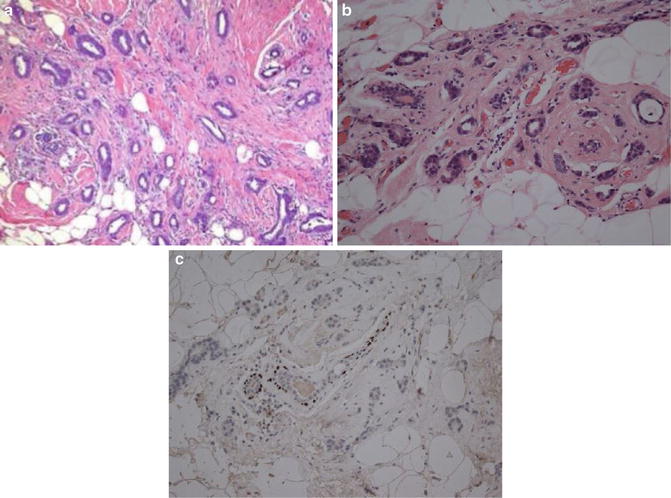
Fig. 10.5
Invasive well-differentiated ductal carcinoma. Lack of myoepithelial cells (c, p63 stain) (Journal of Clinical Pathology, American Society of Clinical Pathology, 2013 with permission)
Key Morphological Features of Low-Grade Invasive Lobular Carcinoma
Uniform discohesive cells in a single cell file, trabeculae, and sheets in fibrous stroma
Discussion
In contrast to malignant salivary tumors, most of which belong to one of those well-characterized morphological subtypes, the vast majority of breast cancers are invasive ductal carcinomas with heterogeneous microscopic appearances (invasive ductal carcinoma, NOS). The rest of them are made up by invasive lobular carcinomas and those rare special subtypes. As with the precursor lesions, the ductal and lobular and tubular designations connote tumor cell differentiation toward the three parts of the TDLU rather than the site of origin. The special subtypes are singled out because of their distinct histomorphological presentations and/or associated clinical outcomes. The tubulolobular carcinoma subtype is characterized by having distinct areas of both ductal and lobular features.
Stay updated, free articles. Join our Telegram channel

Full access? Get Clinical Tree



